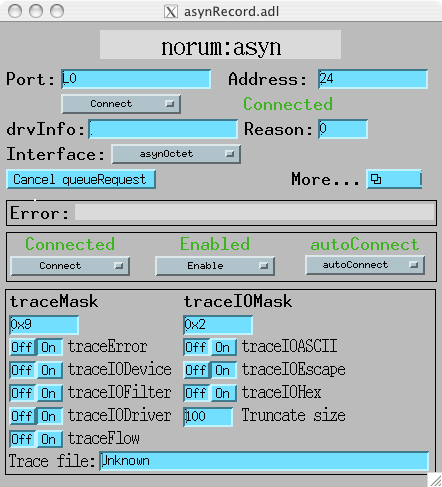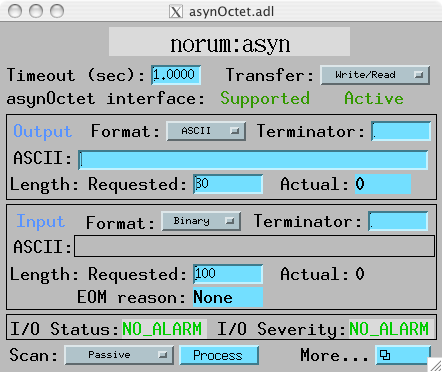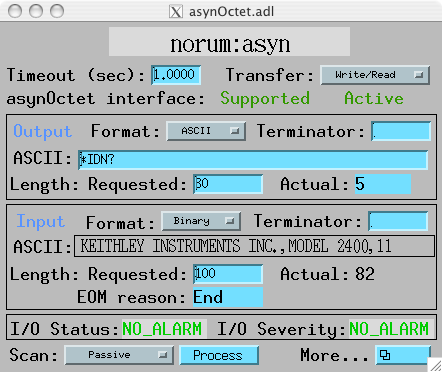asyn Record I/O Example
This document describes how to use an asyn record to communicate with a message-based instrument.
It is a step-by-step example of how I set up simple instrument control using only an asyn record. The instrument may be connected to a local serial port, a USB/Serial adapter, a LAN/Serial adapter, a network port (raw TCP or VXI-11), a local GPIB interface or a LAN/GPIB adapter.
Create a new application
mkdir serialTest cd serialTest /usr/local/epics/R3.14.11/bin/darwin-x86/makeBaseApp.pl -l /usr/local/epics/R3.14.11/bin/darwin-x86/makeBaseApp.pl -t ioc serialTest< /usr/local/epics/R3.14.11/bin/darwin-x86/makeBaseApp.pl -i -t ioc serialTest
Add ASYN support. Edit configure/RELEASE and add a line specifying the path to your ASYN installation
ASYN=/usr/local/epics/R3.14.11</modules/soft/asyn
Edit serialTestApp/src/Makefile and add two lines. It should be apparent from the template where these lines are to be placed:
serialTest_DBD += drvVxi11.dbd serialTest_LIBS += asyn
For a local serial port or a USB/Serial adapter, replace drvVxi11 with drvAsynSerialPort. For a ‘telnet’ style network port (instrument or LAN/Serial adapter), replace drvVxi11 with drvAsynIPPort.
Edit serialTestApp/Db/Makefile and add a line:
DB_INSTALLS += $(ASYN)/db/asynRecord.db
Edit iocBoot/iocSerialTest/st.cmd and add lines to configure the serial, GPIB or network port and to load an ASYN record.
Here’s a complete st.cmd file showing how things should look when you’re finished. You will, of course, have to substitute the IP address of your GPIB/LAN adapter and the address of your GPIB device. You’ll likely want to choose a different value for the PV name prefix macro (P) as well. The IMAX and OMAX values should be large enough to handle the longest messages you expect.
#!../../bin/darwin-x86/serialTest <envPaths cd ${TOP} ## Register all support components dbLoadDatabase("dbd/serialTest.dbd",0,0) serialTest_registerRecordDeviceDriver(pdbbase) ## Configure devices vxi11Configure("L0","164.54.8.129",0,0.0,"gpib0",0,0) ## Load record instances dbLoadRecords("db/asynRecord.db","P=norum:,R=asyn,PORT=L0,ADDR=24,IMAX=100,OMAX=100") cd ${TOP}/iocBoot/${IOC} iocInit()If you are using a LAN/Serial adapter or network attached device which uses a raw TCP (‘telnet’ style) connection you would replace the vxi11Configure command with a line like:
drvAsynIPPortConfigure("L0","192.168.0.23:4001",0,0,0)
If you are using a local serial port or USB/Serial adapter replace the vxi11Configure command with something like:
drvAsynSerialPortConfigure("L0","/dev/tty.PL2303-000013FA",0,0,0) asynSetOption("L0", -1, "baud", "9600") asynSetOption("L0", -1, "bits", "8") asynSetOption("L0", -1, "parity", "none") asynSetOption("L0", -1, "stop", "1") asynSetOption("L0", -1, "clocal", "Y") asynSetOption("L0", -1, "crtscts", "Y")
Build the application (run make from the application top directory).
Start the IOC
cd iocBoot/iocserialTest ../../bin/darwin-x86/serialTest st.cmd
From another window, start MEDM. Make sure that the P and R macro values match those from st.cmd.
medm -x -macro "P=norum:,R=asyn" /usr/local/epics/R3.14.11/modules/soft/asyn/medm/asynRecord.adl
You should see something like the window shown below. I’ve made a few changes to the original values including increasing the trace I/O truncate size to 100 characters, enabling the traceIOEscape display and turning on traceIODriver debugging.
Main control screen, asynRecord.adl

asynRecord.adl
Click on the ‘More…’ button and bring up the “asynOctet Interface I/O” window. I’ve made some changes here as well. I’ve selected Binary input format and increased the requested input length to 100. If your device messages are 40 characters or less you don’t have to make this change. If you’re using a non-GPIB device you probably need to specify appropriate input and output terminator characters.
asynOctet I/O screen, asynOctet.adl

asynOctet.adl
Try entering some commands. A good one to start with is the SCPI Device Identification (*IDN?) command. You can see why I had to arrange for reply messages longer than the default 40 characters!
asynOctet I/O screen, asynOctet.adl

asynOctet.adl
The readback display is truncated. Since I have traceIODriver enabled I can see the entire message in the IOC console window:
2007/09/20 09:01:15.998 L0 24 vxiWrite
*IDN?
2007/09/20 09:01:16.009 L0 24 vxiRead
KEITHLEY INSTRUMENTS INC.,MODEL 2400,1163289,C30 Mar 17 2006 09:29:29/A02 /K/J\n
If your requirements are modest, you might be done. The asyn record may be adequate for your application. If not, you should investigate the Streams device package for writing support for your instrument.